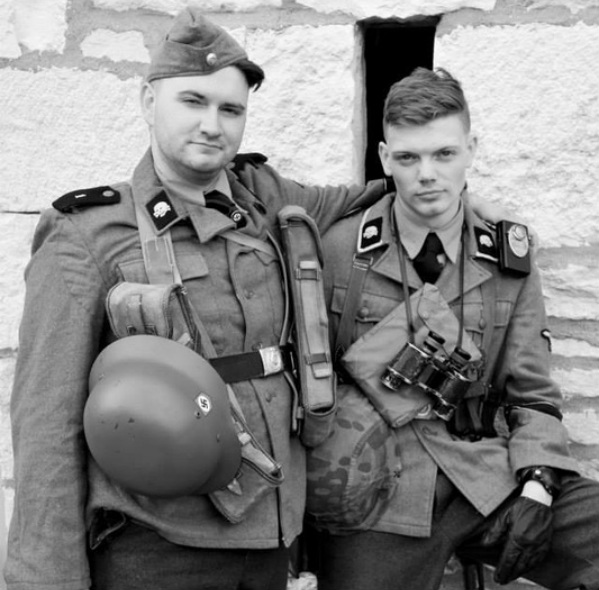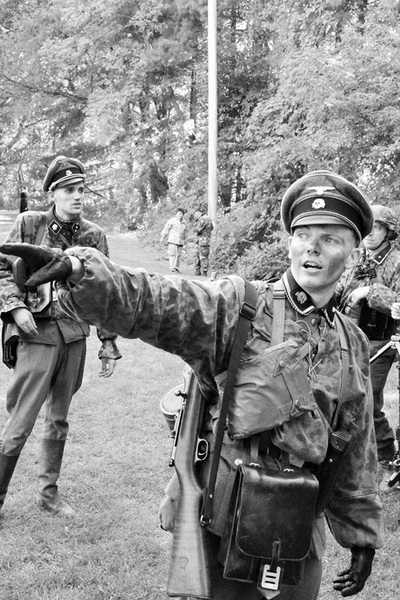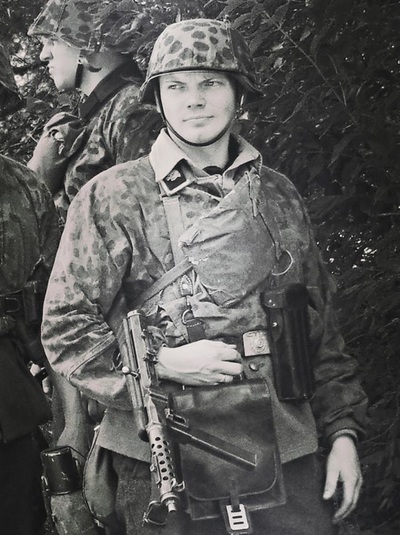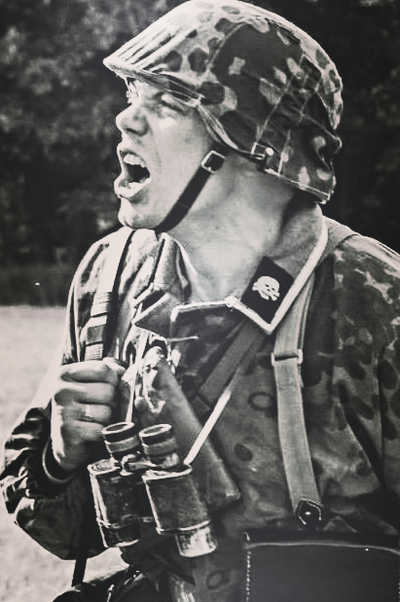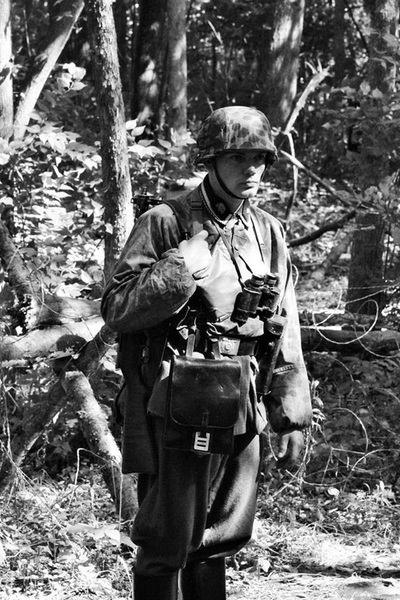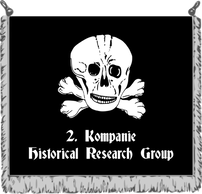SS-Scharfuhrer wulf menges
awards: |
Sudetenland Medal: 20. Nov. 1938
DRL Sports Badge in Bronze: 27. Mai. 1938 Anschluss Medal: 30. Mai. 1938 SA Sports Badge in Bronze: 16. Okt. 1939 Infantry Assault Badge in Silver: 18. Aug. 1940 Wound Badge in Black: 18. Aug. 1940 Iron Cross 2nd Class: 22. Mar. 1942 |
promotions: |
SS-Schutze: 12. Marz. 1937
SS-Sturmmann: 21. Aug. 1938 SS-Rottenfuhrer: 16. Okt. 1939 SS-Unterscharfuhrer: 18. Apr. 1940 SS-Scharfuhrer: 22. Mar. 1942 |
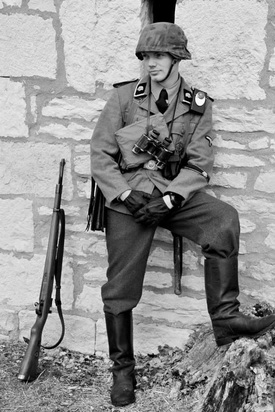
Wulf Menges was born and raised in Bad Tolz, who came from a wealthy, conservative Bavarian family. Even in his early life, Wulf was a bit of a trouble maker, and this habit followed him through his life. His brother, Dagmar Menges was the child that made the Menges parents proud. His sister, Ingrid Menges teaches Deutsch culture and history at a gymnasium in Furstenfeldbruck.
His parents were Jürgen Kern Von Menges, who was a regional manager for Dräger, and Michelle Von Menges. Feeling like the black sheep of the family, Wulf constantly acted out in his youth and fell in with a group of Freikorps vets, and various street gangs. In 1936, Wulf joined the SA, and served as a driver. A year later, he joined the SS, and ended up in the SS-TV, serving in Dachau as a camp guard.
In 1938, he was transferred to the SS-Verfügungstruppe, and served with this unit in Poland. Meanwhile, his brother Dagmar continued to make the family proud, serving as a Fähnrich in Braunschweig I.R. 17.
After the Invasion of Poland, he was promoted to the rank of SS-Rottenfuhrer, and was selected to be sent to the SS-Unterfuhrerschule at Dachau for training to become a Non-Commissioned Officer.
Following his graduation from the SS-Unterfuhrerschule, he was promoted to the rank of SS-Unterscharfuhrer, and assigned to the newly formed SS-Totenkopf-Division. He spent the rest of the time prior to the invasion getting to know his men and training with his newly assigned unit, 2./SS-Totenkopf-Infanterie-Regiment 1.
His parents were Jürgen Kern Von Menges, who was a regional manager for Dräger, and Michelle Von Menges. Feeling like the black sheep of the family, Wulf constantly acted out in his youth and fell in with a group of Freikorps vets, and various street gangs. In 1936, Wulf joined the SA, and served as a driver. A year later, he joined the SS, and ended up in the SS-TV, serving in Dachau as a camp guard.
In 1938, he was transferred to the SS-Verfügungstruppe, and served with this unit in Poland. Meanwhile, his brother Dagmar continued to make the family proud, serving as a Fähnrich in Braunschweig I.R. 17.
After the Invasion of Poland, he was promoted to the rank of SS-Rottenfuhrer, and was selected to be sent to the SS-Unterfuhrerschule at Dachau for training to become a Non-Commissioned Officer.
Following his graduation from the SS-Unterfuhrerschule, he was promoted to the rank of SS-Unterscharfuhrer, and assigned to the newly formed SS-Totenkopf-Division. He spent the rest of the time prior to the invasion getting to know his men and training with his newly assigned unit, 2./SS-Totenkopf-Infanterie-Regiment 1.
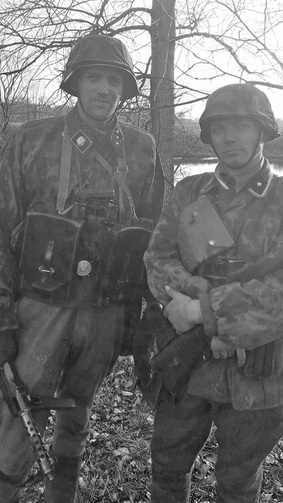
Wulf Menges proved his worth when the Division first entered combat during the Invasion of France. At this time a Gruppenfuhrer, he participated in the Battle of Arras, as well as the siege of Bethune, and was with the Division as it chased the British and French back to Dunkirk.
However, his prior experience in the SA, and the SS-Totenkopfverbande shined through his performance in the field. He faught with tanacity and great zeal, however his brutal nature, learned during the pre-war years came to fruition when he was repremanded by his Zugfuhrer, SS-Untersturmfuhrer Otto Zoepf for executing several men dressed as civillians, whom SS-Unterscharfuhrer Menges believed to be French soldiers in hiding. This instance occured after the Gruppe led by Menges fell under sniper fire in a small French hamlet, and several of his men were killed, but upon arrival to the hamlet, no soldiers were found, only the men claiming to be civillians.
However, before this reprimand could make it's way up the chain it was destroyed by SS-Untersturmfuhrer Zoepf after Menges threw Zoepf out of the line of destruction and was himself wounded in the rear-end by grenade fragments. Zoepf's life was saved, and only received minor injuries. Both men received the Wound Badge in Black.
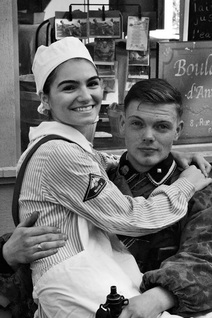
Following the Campaign in France, SS-Unterscharfuhrer Menges was reccommended to go to the SS-Junkerschule in Bad Tolz, for training to become an officer.
However, he did not want the promotion to officer, and subsequently would not receive one after his reccommendation was revoked by Battalion Commander, SS-Sturmbannfuhrer Hellmuth Becker, for using a Non-Totenkopf brothel, and coming down with a venarial desease that was then passed on to several of the field nurses stationed near the SS-Totenkopf-Division on the French Coast.
Remaining an SS-Unterscharfuhrer, Wulf Menges spent the next year training new replacements to the Division, and in July of 1941, along with the rest of the SS-Totenkopfdivision, SS-Uscha. Menges rolled into Russia.
However, he did not want the promotion to officer, and subsequently would not receive one after his reccommendation was revoked by Battalion Commander, SS-Sturmbannfuhrer Hellmuth Becker, for using a Non-Totenkopf brothel, and coming down with a venarial desease that was then passed on to several of the field nurses stationed near the SS-Totenkopf-Division on the French Coast.
Remaining an SS-Unterscharfuhrer, Wulf Menges spent the next year training new replacements to the Division, and in July of 1941, along with the rest of the SS-Totenkopfdivision, SS-Uscha. Menges rolled into Russia.
Still assigned to 2./SS-Totenkopf-Infanterie-Regiment 1., SS-Uscha. Menges survived the brutal assault on the Stalin Line, and all the fighting on the drive to Leningrad. In the Fall of 1941, the Division found itself digging into the Valdai Hills near Lake Ilmen in Russia. In February, 1942, the Soviet Army launched a massive counter-attack, which ended up encircling the entire Division, as it held the line, and failed to retreat with the rest of the German Army.
Wulf was awarded the Iron Cross 2nd Class in March of 1942, when his Zug was completely cut-off and had taken massive casualties, however, Wulf Menges, being the highest ranking survivor managed to lead his understrength unit on a counter-attack, breaking out and re-joining the rest of the Division. His quick thinking and aggressive tactics, saved the lives of the survivors of his Zug. He was also promoted to the rank of SS-Scharfuhrer and assumed command of his Zug.
Although the Division was still encircled, Menges never lost hope in an ultimate victory. Eventually, in May, the Division would break out of the encirclemant, known as the "Demjansk Kessel", Menges only hoped he would survive long enough to see that happen.
Wulf was awarded the Iron Cross 2nd Class in March of 1942, when his Zug was completely cut-off and had taken massive casualties, however, Wulf Menges, being the highest ranking survivor managed to lead his understrength unit on a counter-attack, breaking out and re-joining the rest of the Division. His quick thinking and aggressive tactics, saved the lives of the survivors of his Zug. He was also promoted to the rank of SS-Scharfuhrer and assumed command of his Zug.
Although the Division was still encircled, Menges never lost hope in an ultimate victory. Eventually, in May, the Division would break out of the encirclemant, known as the "Demjansk Kessel", Menges only hoped he would survive long enough to see that happen.
DISCLAIMER: 2. Kompanie is a non-political organization We do not support naziism, or fascism. We are not associated with nor do we condone the actions of the Third Reich or the actual 3.SS Division.
